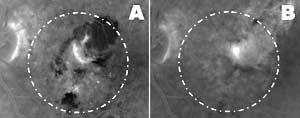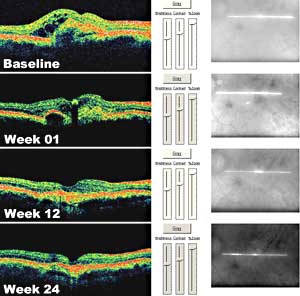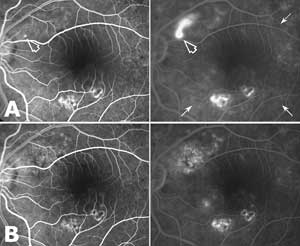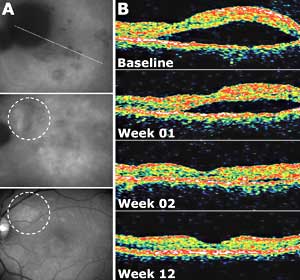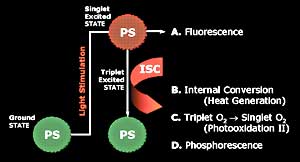Hybrid laser-dye procedure to be tested in multi-center clinical trial in Brazil
Investigators believe that i-MP could be a safe and effective adjunct to existing anti-angiogenic therapies for CNV.
A novel hybrid laser-dye procedure, called indocyanine green-mediated photothrombosis, holds great potential for treating various forms of choroidal neovascularization. This procedure, known as i-MP, seems out of place in the recent era of angiogenic pharmaco-modulation, but it actually could represent a fascinating adjunct to anti-angiogenic agents that are currently available.
After 3 years seeking the means to perform a controlled, multicenter study to assess the clinical value of the treatment and to better understand the major mechanism of action, we have secured funding and are moving forward with such a study.
The study involves the joint effort of physicians – who will not be financially compensated – from 10 ophthalmic centers in Brazil and two Brazilian companies that are providing laser devices, dyes and contract research organization (CRO) monitoring. The companies that are financing the trial are Opto Eletrônica S.A. and Ophthalmos Industria e Comercio de Produtos Farmacêuticos Ltda.
The investigators will evaluate the safety and efficacy of i-MP for the management of neovascular AMD (further information at www.ClinicalTrials.gov).
If our preliminary results are reproducible, we believe i-MP could at some point work synergistically with antiangiogenic agents, such as Macugen (pegaptanib sodium injection, Pfizer/OSI), or Lucentis (ranibizumab, Genentech). If this is possible, the combination could set patient free from the monthly and, to date, eternal eye injection schedule needed to sustain the beneficial effects of pegaptanib/ranibizumab therapy in the setting of neovascular AMD.
Currently, only one photosensitizing agent, Visudyne (verteporfin for injection, QLT/Novartis Ophthalmics) has proven efficacy for use in ophthalmology.
The concept of i-MP is based on the use of low irradiance continuous ~810-nm laser application to photoactivate ICG at one targeted abnormal (pathologic) tissue with recognized increased uptake of the dye, with therapeutic effects essentially arising from photooxidative reactions (types 1 and 2) of the photoactivated dye within the “lesion.” For such a purpose, we have adopted a dedicated two-fold scheme for light application as well as for dye infusion.
|
Images: Costa RA |
Two-fold scheme for ICG infusion
In our initial report on the use of i-MP for CNV management in AMD, a dose of 1.5 mg/kg was used, in keeping with the recommended maximum ICG dose in humans (2.0 mg/kg). A 0.5 mg/kg ICG dose was utilized at that time for an ICG angiography study several minutes prior to the treatment session on those patients.
Based on the induced response over time utilizing quite a few combinations of ICG doses and dosing schedules, we noted that a better therapeutic effect was achieved in those patients in which ICG angiography studies had been performed at the same visit of the i-MP treatment session, even if lower (1.0 mg/kg to 1.5 mg/kg) ICG doses were used for treatment.
In the pilot studies, the positive influence of having some residual ICG uptake in the targeted tissue prior to the treatment dose became more evident. As a result, we adopted the twin ICG infusion scheme for i-MP.
In theory, higher photochemical effects occurs rather in those tissues involved in the treatment laser spot that have been formerly “ICG-loaded” than in the normal tissues that presents minimal or no ICG residual up-take from the first ICG injection.
Two-fold light delivery technique
In addition to a two-step ICG infusion proposal, light delivery for i-MP is also performed in a two-fold scheme.
ICG-mediated photodynamic effects have been experimentally demonstrated in vitro and in vivo after a single 810-nm laser application. However, an increase in the laser intensity (measured in W/cm2) was needed to compensate for the lower maximum human tolerated ICG dose in order to induce a satisfactory effect in the clinical scenario.
Experimental observations and theoretical models have suggested that intensity is the main factor contributing to temperature changes in laser-treated tissues. This theory is borne out by the relative effects of various lasers that are used clinically.
A faster and more intense increase in tissue temperature occurs when conventional photocoagulation is used than when much higher energy (measured in J/cm2) is delivered in a continuous pulse with lower intensity, for example, as used for TTT in neovascular AMD.
Accordingly, during preliminary i-MP studies, it was also noted that increase of laser intensity to some extent was not related to a better response; to the contrary, increased intensity eventually caused retinal damage without producing any additional therapeutic effects on the targeted tissues.
By adopting a two-fold scheme of low intensity light delivery, we were able to optimize ICG photoactivation in the targeted tissue while avoiding the undesirable thermal effects arising from random absorption of the laser energy by the endogenous pigment in the choroid and retinal pigment epithelium, which are commonly observed in higher-intensity laser treatments.
|
|
Mechanisms of action unclear
With respect to the mechanisms of action of i-MP, it is actually impossible to determine exactly how photodynamic or photothermal is the generated response after ICG photoactivation in the clinical scenario.
We hypothesized over a mixed type 1 (heat generation) and 2 (singlet oxygen formation) photooxidation therapy to explain the observed effects in i-MP. For this reason, we changed the initial terminology proposed for the procedure from i-PDT to i-MP.
Although its mechanisms of action remain unclear, we know that selective treatment response has been achieved by combining the aforementioned factors related to ICG-infusion and light-delivery schemes used in i-MP.
In our series, the spot size used for light delivery has been larger than the targeted lesions, and no obvious deleterious effects could be observed in presumably normal tissues within the treatment area by clinical examination, fluorescein and ICG angiography or optical coherence tomography.
|
For more information:
- Rogério A. Costa, MD, PhD, is director of the Advanced Diagnostic and Treatment Unit in the Hospital de Olhos Araraquara, SP, Brazil. He can be reached at Rua Padre Duarte 989, Apart. 172, Araraquara, São Paulo, Brazil 14801-310; tel/fax: 55-16-3331-1001. Dr. Costa has no financial interest in any of the products mentioned. He is an unpaid consultant for Opto Elêtronica.

